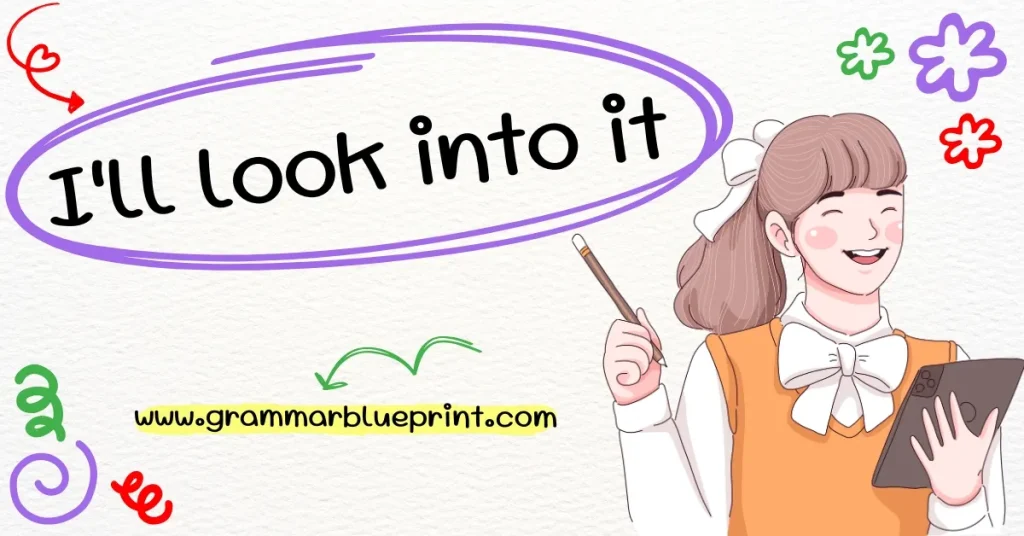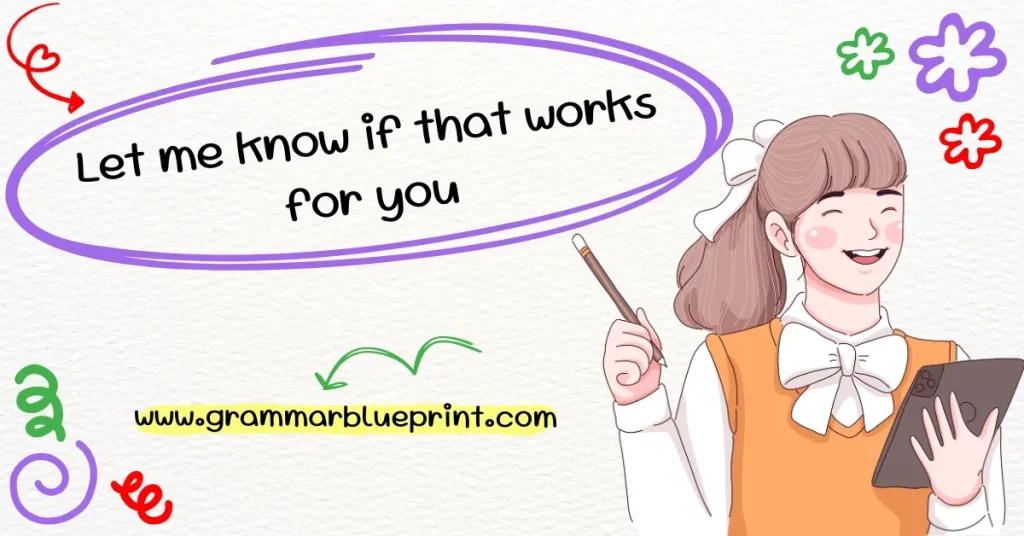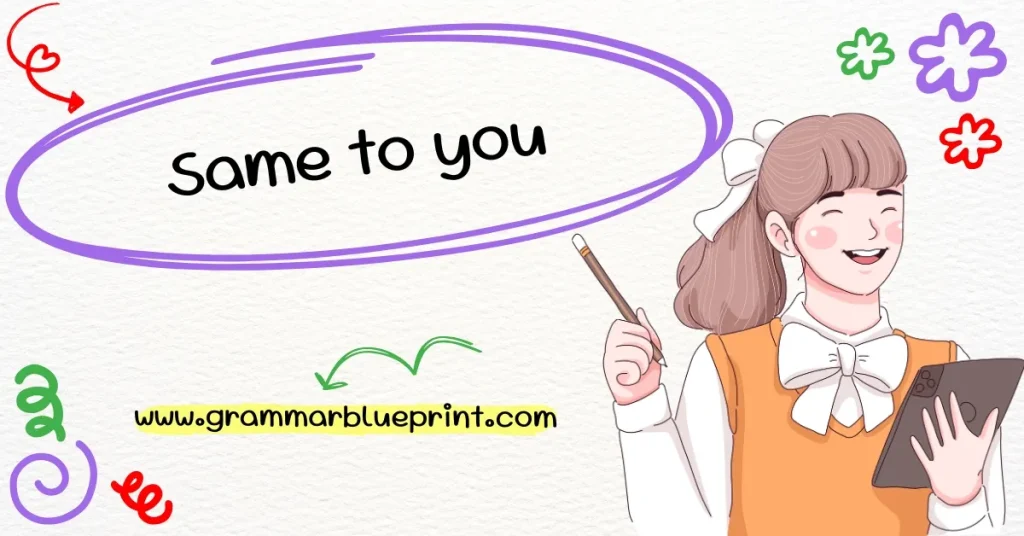We all use phrases like “I’ll look into it” to show that we’re taking responsibility for something or that we’re interested in helping resolve an issue. This simple phrase is commonly used in both professional and personal conversations. But what exactly does it mean, and how can it be used effectively?
What is “I’ll Look Into It”?
“I’ll look into it” is a phrase that signifies a promise to investigate, research, or address a particular issue. It means that the speaker is willing to dedicate time or effort to resolve a matter or find out more about it. The phrase can be used in both formal and informal settings, from business emails to casual conversations.
When you say “I’ll look into it,” you are committing to investigating the problem or question raised, and you are reassuring the other person that you will give it attention. It is a polite and professional way of acknowledging an issue or request without making an immediate decision or answer.
When to Use “I’ll Look Into It”
The phrase “I’ll look into it” is used when someone asks you to do something, solve a problem, or find more information. It can be used in both professional and everyday conversations. Here are some common situations where you might use this phrase:
- In the workplace: When a colleague asks for information, and you need some time to find it.
- Customer service: If a customer reports an issue, and you need to investigate further.
- In casual conversations: If a friend asks you to check something, and you plan to get back to them with an answer.
For example:
- “I’ll look into that and let you know by the end of the day.”
- “That sounds interesting! I’ll look into it and tell you more soon.”
Why Use “I’ll Look Into It”?
Using “I’ll look into it” offers several benefits. It shows that you are willing to take responsibility and that you care about resolving issues or helping someone. This phrase helps maintain professionalism and build trust in both personal and work-related conversations. Here’s why it’s useful:
- Demonstrates commitment: When you say you’ll look into something, you are committing to finding a solution.
- Shows responsibility: It shows that you’re taking ownership of the situation.
- Keeps communication open: You’re giving the other person a clear idea that you will investigate and provide an update, which helps manage expectations.
How to Respond to “I’ll Look Into It”
When someone says “I’ll look into it,” it’s polite to acknowledge their effort and express your appreciation. Here are a few appropriate ways to respond:
- “Thank you, I appreciate it.”
- “I look forward to hearing back from you.”
- “That sounds good. Please let me know when you have an update.”
- “Great, I’ll await your response.”
These responses maintain the flow of communication and show that you’re respectful of the person’s time and effort.
Common Mistakes to Avoid
Although “I’ll look into it” is a useful phrase, there are some common mistakes that you should avoid:
- Overusing the phrase: It can lose its meaning if you say it too often without following through. If you keep saying, “I’ll look into it” but don’t provide an update, others might lose trust in your ability to take action.
- Confusing it with similar phrases: There’s a difference between “I’ll look into it” and phrases like “I’ll check it out” or “I’ll get back to you.” The former implies a deeper investigation, while the latter can simply mean you’ll revisit the topic later.
- Not following up: Saying you’ll look into something is only helpful if you actually do it. Always follow up with the person after a reasonable amount of time has passed.
Examples of “I’ll Look Into It” in Sentences
Here are some examples of how you can use “I’ll look into it” in different situations:
- In the workplace: “I received your request about the report. I’ll look into it and get back to you by tomorrow.”
- Customer service: “I understand your concern about the billing error. I’ll look into it right away and update you shortly.”
- In casual conversations: “Oh, that’s a good point! I’ll look into it and let you know what I find.”
Better Alternatives to Say “I’ll Look Into It”
Sometimes, you might want to use a different phrase to convey the same meaning. Here are 30 alternatives to “I’ll look into it,” each explained with its meaning and best use:
1. I’ll check on that
- Meaning: You plan to find out more about a situation.
- Best Use: When confirming something or checking on status.
- Tone: Casual, but still professional.
2. Let me investigate that
- Meaning: A slightly more formal way to say you will research the matter.
- Best Use: In formal situations, like legal or technical inquiries.
- Tone: Formal, thorough.
3. I’ll take a closer look
- Meaning: Indicates you will examine something more carefully.
- Best Use: When you want to give something a detailed review.
- Tone: Professional, focused.
4. I’ll examine that
- Meaning: Similar to “take a closer look,” but a bit more formal.
- Best Use: For situations that require a detailed, methodical analysis.
- Tone: Formal, detailed.
5. Let me find out more
- Meaning: Implies you’ll gather additional information.
- Best Use: When you need to look for extra details.
- Tone: Neutral, helpful.
6. I’ll check it out
- Meaning: Informal version of looking into something.
- Best Use: Casual conversations or when doing a quick investigation.
- Tone: Casual, friendly.
7. I’ll see what I can do
- Meaning: Indicates willingness to help or take action.
- Best Use: In situations where you’re uncertain of the exact outcome.
- Tone: Helpful, positive.
8. I’ll get back to you on that
- Meaning: You will follow up after doing some research.
- Best Use: When you need more time to gather the information.
- Tone: Professional, considerate.
9. Let me research that
- Meaning: Implies you’ll spend some time investigating the issue.
- Best Use: When research is required to solve the problem.
- Tone: Professional, thorough.
10. I’ll gather more information
- Meaning: Suggests you’ll collect additional data or facts.
- Best Use: When more input is needed before making a decision.
- Tone: Formal, focused.
11. I’ll explore that
- Meaning: Suggests you will look into the issue from different angles.
- Best Use: When you want to consider various aspects.
- Tone: Inquisitive, open-minded.
12. I’ll dig into that
- Meaning: Implies a deeper level of investigation.
- Best Use: When the issue is complex and requires thorough examination.
- Tone: Determined, focused.
13. Let me look into that for you
- Meaning: A polite way of offering to investigate something.
- Best Use: Offering help in professional or customer service settings.
- Tone: Polite, service-oriented.
14. I’ll follow up on that
- Meaning: Indicates you will check back after an initial investigation.
- Best Use: When a follow-up is necessary after a first inquiry.
- Tone: Professional, reliable.
15. I’ll see to that
- Meaning: Implies you will handle the situation.
- Best Use: When you want to take charge of solving an issue.
- Tone: Authoritative, confident.
16. I’ll review that
- Meaning: Suggests you will go over something carefully.
- Best Use: When you need to assess or evaluate something.
- Tone: Professional, analytical.
17. Let me go over that
- Meaning: A bit less formal than “review,” but implies careful checking.
- Best Use: In both professional and casual settings when you need to clarify or verify information.
- Tone: Casual but diligent.
18. I’ll figure it out
- Meaning: A straightforward way of saying you will solve the issue.
- Best Use: Casual settings where you need time to resolve something.
- Tone: Confident, informal.
19. I’ll check with someone about that
- Meaning: Indicates you’ll consult with others for information.
- Best Use: When you need to verify something with colleagues or experts.
- Tone: Collaborative, professional.
20. I’ll verify that
- Meaning: Suggests you’ll confirm or validate the information.
- Best Use: When you need to ensure the accuracy of something.
- Tone: Formal, precise.
21. I’ll investigate further
- Meaning: Suggests deeper exploration into the issue.
- Best Use: When the issue requires additional focus.
- Tone: Thorough, professional.
22. Let me look into it further
- Meaning: Implies you’ll continue the investigation or inquiry.
- Best Use: When more time is needed to get a full answer.
- Tone: Considerate, professional.
23. I’ll ask around
- Meaning: Informally suggesting you will consult with others.
- Best Use: Casual settings where you need to gather informal information.
- Tone: Friendly, informal.
24. I’ll get to the bottom of that
- Meaning: Indicates you will fully understand or resolve an issue.
- Best Use: When something requires thorough analysis or investigation.
- Tone: Determined, confident.
25. I’ll track that down
- Meaning: Suggests you will search for something that is missing or unclear.
- Best Use: When you need to locate or clarify something.
- Tone: Persistent, focused.
26. I’ll see what I can find
- Meaning: A casual way of saying you’ll look for answers.
- Best Use: When the outcome is uncertain but you will try.
- Tone: Casual, open.
27. Let me check with the team
- Meaning: Indicates you will consult with others in your organization.
- Best Use: When you need group input before giving a response.
- Tone: Collaborative, professional.
28. I’ll make some inquiries
- Meaning: Implies that you’ll ask around for information.
- Best Use: In formal situations when you need to seek further information.
- Tone: Formal, thorough.
29. I’ll look into the details
- Meaning: Suggests that you’ll examine the finer points of a matter.
- Best Use: When focusing on specifics or small elements of a larger issue.
- Tone: Detailed, precise.
30. I’ll check on the status of that
- Meaning: Implies you’ll find out the current progress or condition.
- Best Use: When asking for updates or status reports.
- Tone: Professional, concerned.
Benefits of Using “I’ll Look Into It” in Professional Communication
Using “I’ll look into it” in professional communication helps convey responsibility, professionalism, and a willingness to resolve issues. It assures colleagues, clients, and stakeholders that their concerns are being taken seriously, while maintaining trust and confidence in your problem-solving skills. It’s a tool for setting expectations and ensuring clear communication without overpromising or committing prematurely.
Tips for Using “I’ll Look Into It” Effectively
- Be realistic: Don’t use the phrase if you don’t have time to follow through. Instead, communicate your availability clearly.
- Set a timeline: Whenever possible, include when you will get back with more information.
- Follow up: Always follow through after saying you’ll look into something. If there are delays, let the other person know.
By using “I’ll look into it” effectively, you demonstrate professionalism and a proactive approach to problem-solving.



